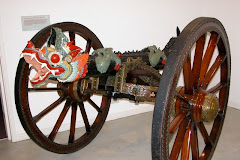Engaging targets at indirect fire - i.e. targets that can not be seen from the gun position - is quite a complex business. In an ideal situation, it should be possible simply to determine where a target is in relation to a gun in terms of a compass bearing and a distance, to set these on an appropriate sighting system on the gun and to hit the target with the first round fired. Unfortunately for gunners, situations are seldom ideal!
Let us look at some of the factors that affect indirect fire.
The gunner has first to know exactly where on the map his gun is sited, and to ensure that when his gun is pointed on a given compass bearing, it is truly pointing on that bearing. It is surprisingly easy to be wrong on both accounts, which can obviously result in missing the target. It is of course important for the target's position to be accurately located on that same map grid, since the bearing and range to it are determined by comparing the two locations. In effect, a line drawn on the map between the gun and target provides the bearing (the angle between that line and grid north), while the length of the line is the scale of the distance, or range.
But even when those pieces of information are known, the gun has to be able to shoot 'to the map' - i.e. perform to a set of standards that are laid down as 'normal conditions'. When a gun is calibrated, the gunner determines to what extent its performance matches the standard set for that gun. There are many factors that can make it differ in practice and these have to be taken into account in setting target information on the sights. The main non-standard condition on the gun itself is any difference in muzzle velocity for the charge being fired. Gun barrels get worn by the corrosive gases and the passage of shells, and as they wear they become less able to achieve the standard muzzle velocity. A lower than standard velocity means the shell will not go as far as it should when the range is set at a given distance (angle of elevation), so that non-standard muzzle velocity has to be taken into account by increasing the range set.
Another important factor at the gun is the ambient temperature of the propelling charge. Propellant burns faster when the ambient temperature is above standard, leading to higher muzzle velocity, so again, compensation is needed. Projectiles can vary in weight, and although the weight differences from round to round are not large, they nevertheless have an effect on the range achieved and need compensation.
It is obvious that the shell is affected in flight by atmospheric conditions - wind speed and direction are obvious examples, but perhaps it is not as well known that these can vary at the different levels along the trajectory and require compensation in the settings on the gun before firing. Barometric pressure affects air density and that determines what air resistance is offered to the shell in flight. On a long trajectory, even the rotation of the Earth can become a significant factor and need compensating adjustments.
Some factors, such as 'drift', are built in to all situations. Drift is the tendency of a spinning projectile to build up pressure on one side and hence drift away from that pressure. That effect is well-known and range tables automatically include it.
These are the most common factors. There are others, but this will be sufficient to make the point that engaging targets at indirect fire is a complex business!
Subscribe to:
Post Comments (Atom)




No comments:
Post a Comment